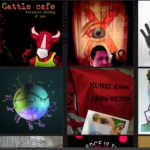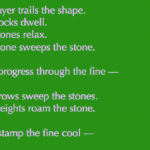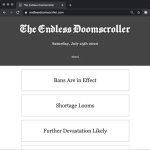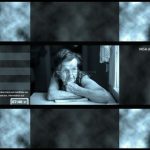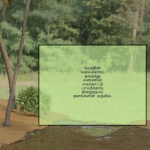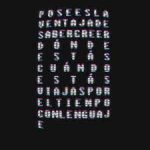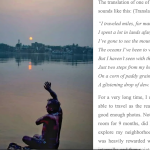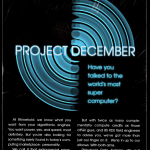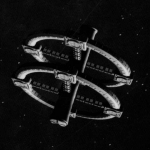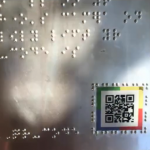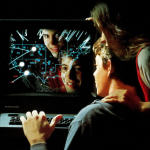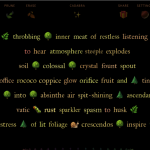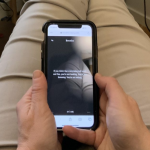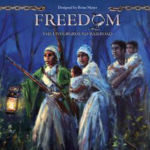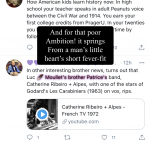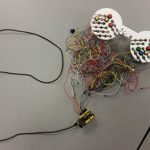2022
While presenting a series of four selected E-Lit artworks, Marques and Gago demonstrate how our recent pandemic will affect new media art, similarly to the ways in which the Athens Plague affected the writing (and reception) of Greek tragedies. And the same goes for Cinema and Aids, smallpox and illustration, photography and the third bubonic plague, usw.
Dani Spinosa reflects on the relocation of e-Lit scholarship and pedagogy "in the remote classroom for the precariat writ large."
As a follow up to the series of interviews with Ben Grosser in February and March 2021 (published later that year in ebr), we include here a more settled, post-pandemic set of reflections. In the interviews, Grosser noted how "the realities of the pandemic necessitated back then," and maybe still does, "a degree of vigilance about new information": is there anything new that we need to know? The flood of information, however, has been less about knowing and acting on that knowledge than it is about keeping us engaged, and returning us daily, hourly, and minute by minute to our digital doomscrolls. For this newly produced populace that is largely stuck online, Grosser here discusses a net art / e-lit project of his own, an alternative software interface called The Endless Doomscroller.
A critical encounter with one of alt-lit (alternative literature) movement’s most renowned contributors, whose moment (like many in this scene) has passed. Citing Christian Howard, Leah Henrickson advances the argument that “[w]e’re at a turning point in literary studies, and we need to confront how the changes in mode are affecting – and are affected by – the alternative networks of circulation within these digital spaces.”
Through the examples of three types of digital stories, including an interactive narrative for the smartphone based on notifications, a web narrative based on a real time data flow, and the widely used social media feature of stories, Bouchardon and Fülöp explore the relationship between the digital, temporality, and narrative. They ask, "what new narrative forms, or even new concepts of narrative do these new temporal experiences provided by digital technology offer to us?"
Reflections on an emerging digital poetry whose primary theme is ecological loss, and personal reminiscence.
While defining the art object in a post-digital world, Maria Goichoechea de Jorge observes in media artists a nostalgia for an analogue craftsmanship; a rebellion against machinic perfection; and a resistance to forms of human creativity that propel us into an ever more profound symbiosis with our technological lifeworld.
For Saint Augustine, biblical scripture was indispensible to his being able to finish the final draft of his life story. Hemingway advocated stopping midway in a sentence, to ensure a fresh start tomorrow. For us today in the age of algorithmic governance, our stories are more likely to be generated continuously through the words of others using Google search, autocomplete and the algorithm’s statistically-informed guess. In this article, Fernanda Mugica explores the real time writing in charly.gr’s Peronismo (spam), from 2010, a visual poem that combines music and text; Matías Buonfrate's “No poseas un miedo” (2020); and Argentine poet Francisco López Merino's C0d3 P03try.
Building on the work of Souvik Mukherjee (2017), T. Shanmugapriya and Nirmala Menon (2018, 2019), Samya Brata Roy identifies emergent elements of a multimodal E-Lit tradition in India.
Alex Mitchell (leader of the Narrative and Play Research Group at the National University of Singapore) shows how, while generative text adventure AI Dungeon allows players to uncritically interact with the AI system as they co-create a story, Project December instead primes the player for reflection and interpretation. Unlike most digital games, which emphasize immersion, this brings forward the problematic nature of their technology platforms: foregrounding rather than normalizing the strangeness of the experience, or even generating a kind of "spooky magic," as Project December creator Jason Rohrer puts it.
2021
Bruce Clarke focuses transhumanism through the dialects of a neocybernetic systems theory (NST). As Clarke explores the dynamics of a NST, he outlines important components of the AI Imaginary—or, the theoretical and mediated discussions of intelligent technologies--in order to explore how machines, humans, and systems can work together. Specifically, he presents Kim Stanley Robinson’s novel Aurora (2015), as an exception to the AI Imaginary in its representation of “a solidarity that regathers rather than alienates human and machine beings.”
In his essay, Malthe Stavning Erslev approaches the notion of post-digital from the perspective of a broader cultural phenomenon of posterioriy, emphasizing the fact that the prefix post- still allows for discussion of multidirectional and complex changes that our world is currently undergoing. In order to better grasp all the complexities and interrogate somewhat linear periodization implied by the prefix, Erslev employs the oxymoronic concept of contemporary posterity. At the same time, he ties his theoretical proposition with the extensive analysis of an online community engaging in bot-mimicry.
Building on their concept of metainterface, Søren Bro Pold and Christian Ulrik Andersen analyze the change in perception and experience that bring forth the always-on(line) mode of engaging with digital content. The notion of ‘spectacle’, in itself having a long history in critical theory, is employed here to discuss media politics and the struggle for power in terms of aesthetized computation, with their main driving forces being data analytics, surveillance and forensics. Pold and Andersen uncover how metainterface spectacle can also serve to empower political agency through reclaiming the apparatus.
With a focus on sound elements in the e-literary, Hannah Ackermans (University of Bergen, Norway) insightfully traces the role of accessibility and (dis)ability in electronic literature. Problematizing the universality of electronic literature practices and rewriting the familiar concepts (such as defamiliarization or constraint), she uses the notion of accessibility as a perspective that both proposes inclusive models of electronic literature and helps to understand creative work on a fundamental, material level.
In her essay “Is this a game, or is it real?”, Naomi Mandel revisits WarGames, a 1983 film that significantly shaped the popular imagination of computer games and military networked technology at the time. Mandel argues that the film prompts a non-mimetic reading that emphasizes deeper, infrastructural and operational meanings of the screen. Placing it in the context of the history of computer games, Mandel points out that WarGames anticipates the evolution of the medium by playing with distinctions between real world and game, and questioning whether such distinction matters at all.
Literary forms seen as tools of mind transgressing the field of the literary and repurposing digital media so that they are capable of refocusing cognition in beneficial ways – these are the lines of thought shaping Kyle Booten’s analysis of algorithmic co-writers. To be able to respond to both challenges, it is proposed that researchers rigorously and systemically study how digital tools are being creatively used and repurposed, learning from models that have emerged within the mainstream Human-Computer Interaction research.
In a study that traverses more than half a century – going from e-lit precursor Christopher Strachey’s M.U.C. Love Letter Generator (1952) to Michael Joyce’s experimental hypertext afternoon: a story (1990) to Kate Pullinger’s data-driven touchscreen work Breathe (2018) – Rettberg (University of Bergen, Norway) situates experimentation with digital interfaces in a longer tradition of innovation in literary and scholarly production. She also argues for the central importance of such experimentation in the ongoing development of both electronic literature and the digital humanities, suggesting that speculation in the design of digital interfaces can help preserve and extend the interpretative and intuitive aspects of Western literary and scholarly traditions, while also bringing the limitations and exclusions of such knowledge systems into focus.
In this conversation and accompanying "How to Not" guide, Drs. Lai-Tze Fan, Kishonna Gray, and Aynur Kadir consider responsible theories and methods towards racial equity, racial justice, and anti-racism in game design. Their main focus is on how games can provide a platform for helping people understand and learn about these issues.
To browse the internet is to subject oneself to sophisticated and unceasing techniques of attention-capture, of which the pop-up advertisement is only the most crass and vexatious example. This paper describes the development of Nightingale, a web browser extension that fights distraction with distraction. It does this by injecting the web with pop-up ads consisting of semantically-relevant fragments of the poetry of Keats. Nightingale represents an attempt to engage in “noöhacking”—that is, repurposing the cognitively-destructive aspects of contemporary digital media in order to care for one’s own mind.’
This essay explores intersections among queer theory, critical making methodology and inclusive design through a research creation piece that aims to problematize normative video game controller schemes.
